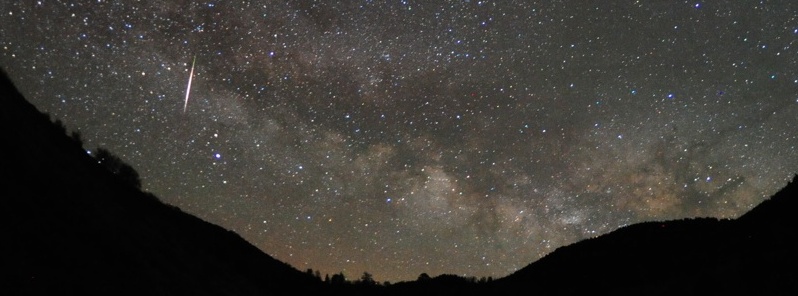Lyrid meteor shower peaks on April 23, 2015

Lyrid meteor shower will reach its maximum activity this year on the morning of April 23, 2015. The Moon will be 5 days old at the time, and so will present minimal interference. Lyrid meteors are known for their luminous dust trains observable for several seconds.
The pieces of space debris that interact with our atmosphere to create the Lyrids originate from comet C/1861 G1 Thatcher discovered on April 5, 1861, but the first recorded sighting of a Lyrid meteor shower goes back to 687 BC which makes them one of the oldest known meteor showers.
Lyrids are known for their fast and bright meteors and though they are not as fast or as plentiful as the famous Perseids in August they can surprise watchers with as many as 100 meteors seen per hour. Sightings of these heavier showers occurred in 1803 (Virginia), 1922 (Greece), 1945 (Japan), and 1982 (U.S.). In general, 10 – 20 Lyrid meteors can be seen per hour during their peak.

Video credit Cory Poole
Although this shower can be seen in both hemispheres, the north is favored as the radiant lies much higher in the sky. Northern Hemisphere observers can expect about 15 shooting stars per hour during the last couple of hours before dawn. About 5 of them per hour are expected in Southern Hemisphere.
They are best viewed in the Northern Hemisphere during the dark hours (after moonset and before dawn). Find an area well away from city or street lights. Come prepared with a sleeping bag, blanket or lawn chair. Lie flat on your back with your feet facing east and look up, taking in as much of the sky as possible. After about 30 minutes in the dark, your eyes will adapt and you will begin to see meteors. Be patient – the show will last until dawn, so you have plenty of time to catch a glimpse.
Their radiant, the point in the sky from which the Lyrids appear to come from, is the constellation Lyra, the harp. Lyrids appear to particularly radiate out from the star Vega, the brightest star within this constellation.
It is better to view the Lyrids away from their radiant as they will appear longer and more spectacular from this perspective.
Featured image: Lyrid meteor shower. Author: Jimmy Westlake.

June 22, 2015 approx. 2330hrs from Altoona, Pennsylvania. Observed, naked eye, a lone glowing small white cloud (clear, cloudless sky w/ no wind) approaching from the south. As it crossed (side view) approx. 1/2 to 2/3 above mountain horizon (I am now viewing west) observed the “cloud” to be white, blurry & gaseous…looking like a comet w/ that classic que tip shape…a white, glowing, fuzzy, blurred ball trailing a short tail. The “comet” was approx. thumb size (to my eye) on the horizon & appeared to be moving about the speed of an aircraft (obviously much faster than an actual comet & slower than a meteor). As it passed the horizon continuing in a north direction, away from my line of sight, it appeared once again to take the shape of an odd, glowing white small cloud. Very unusual & is 1st time I’ve ever observed something like this. I am a casual night sky watcher & regularly observe a plethora of aircraft. I’ve observed many meteors & meteorites and even satellites in occasion. Never this this phenomena.